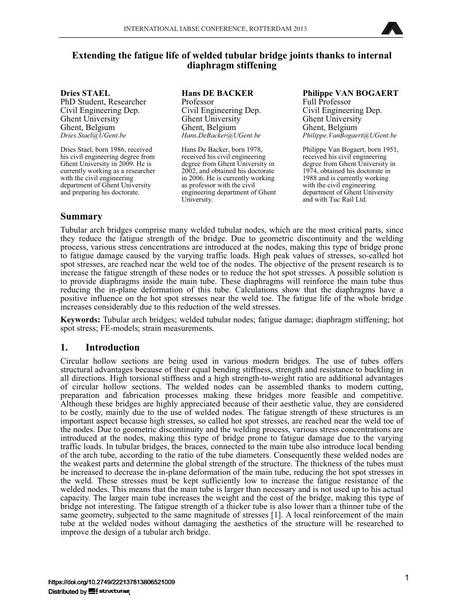Extending the fatigue life of welded tubular bridge joints thanks to internal diaphragm stiffening

|
|
|||||||||||
Bibliographic Details
| Author(s): |
Dries Stael
Hans De Backer Philippe Van Bogaert |
||||
|---|---|---|---|---|---|
| Medium: | conference paper | ||||
| Language(s): | English | ||||
| Conference: | IABSE Conference: Assessment, Upgrading and Refurbishment of Infrastructures, Rotterdam, The Netherlands, 6-8 May 2013 | ||||
| Published in: | IABSE Conference, Rotterdam, May 2013 | ||||
|
|||||
| Page(s): | 442-443 | ||||
| Total no. of pages: | 8 | ||||
| Year: | 2013 | ||||
| DOI: | 10.2749/222137813806521009 | ||||
| Abstract: |
Tubular arch bridges comprise many welded tubular nodes, which are the most critical parts, since they reduce the fatigue strength of the bridge. Due to geometric discontinuity and the welding process, various stress concentrations are introduced at the nodes, making this type of bridge prone to fatigue damage caused by the varying traffic loads. High peak values of stresses, so-called hot spot stresses, are reached near the weld toe of the nodes. The objective of the present research is to increase the fatigue strength of these nodes or to reduce the hot spot stresses. A possible solution is to provide diaphragms inside the main tube. These diaphragms will reinforce the main tube thus reducing the in-plane deformation of this tube. Calculations show that the diaphragms have a positive influence on the hot spot stresses near the weld toe. The fatigue life of the whole bridge increases considerably due to this reduction of the weld stresses. |
||||
| Keywords: |
fatigue damage hot spot stress strain measurements Tubular arch bridges welded tubular nodes diaphragm stiffening FE-models
|
||||
